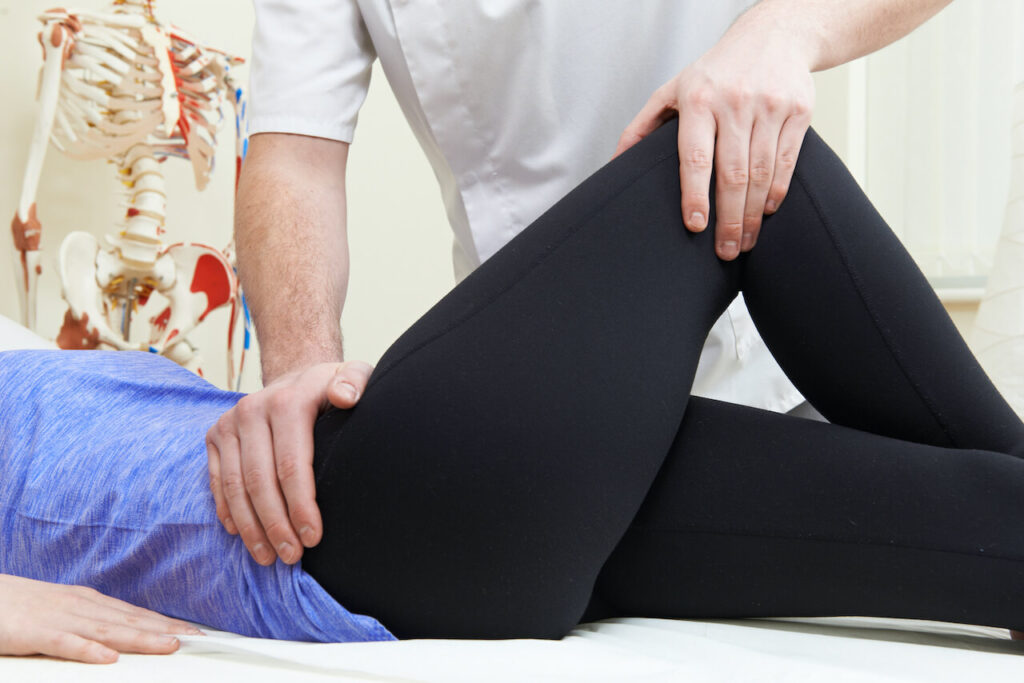The Benefits of Physiotherapy for Knee Pain

Knee pain can be a real bummer. It stops you from doing things you love and makes everyday tasks a chore. But there’s good news! Physiotherapy can help ease your discomfort and get you moving again.
Physiotherapy uses targeted exercises and hands-on treatments to reduce knee pain and improve function. Your physiotherapist will create a plan just for you. This plan might include stretches, strength training, and special techniques to help your knee feel better.
Don’t let knee pain hold you back. The team at Lake Country Physiotherapy in Orillia is ready to help. We have the skills and tools to get you on the path to recovery.
Understanding Knee Pain
Knee pain affects many people and can have various causes. Knowing the knee’s structure, common pain sources, and diagnosis methods helps manage this issue.
Anatomy of the Knee
Your knee is a complex joint with several key parts. It connects your thigh bone (femur) to your shin bone (tibia). The kneecap (patella) sits in front. Cartilage covers the bone ends, acting as a cushion. Ligaments hold the bones together and give stability.
The knee has four main ligaments:
- Anterior cruciate ligament (ACL)
- Posterior cruciate ligament (PCL)
- Medial collateral ligament (MCL)
- Lateral collateral ligament (LCL)
Tendons connect muscles to bones. The quadriceps tendon links the thigh muscles to the kneecap. The patellar tendon connects the kneecap to the shin bone.
Common Causes of Knee Pain
Knee pain can stem from various issues. Injuries like sprains, strains, and tears are frequent causes. These often happen during sports or accidents.
Arthritis is another major source of knee pain. Osteoarthritis, the most common type, occurs when cartilage wears down. Rheumatoid arthritis causes joint inflammation.
Other possible causes include:
- Bursitis (swelling of fluid-filled sacs)
- Tendinitis (inflamed tendons)
- Patellofemoral pain syndrome (pain around the kneecap)
- Iliotibial band syndrome (tightness in a hip muscle)
Being overweight puts extra stress on your knees. This can lead to pain and increase your risk of arthritis.
Benefits of Physiotherapy for Knee Pain
Physiotherapy can help you get back on your feet and reduce knee pain. It offers ways to ease discomfort, boost movement, and keep your knees healthy for the long run.
Reducing Pain and Inflammation
Physiotherapy uses many tools to tackle knee pain. Ice and heat therapy can ease swelling and discomfort. Your therapist might use ultrasound to send gentle sound waves into your knee. This can help reduce pain deep in the joint.
Gentle massage can also soothe sore muscles around your knee. Some therapists use special tapes to support your knee and cut down on pain. Other therapists use acupuncture points around the knee. These methods work together to make your knee feel better.
Electric stimulation is another option. Small electric pulses can block pain signals and help your muscles relax. With less pain, you’ll find it easier to move and do your daily tasks.
Improving Mobility and Strength
Physiotherapy isn’t just about easing pain. It’s also about getting you moving again. Your therapist will teach you exercises to make your knee stronger and more flexible.
These might include:
- Straight leg raises
- Wall squats
- Hamstring curls
- Clamshells (yes, hip exercise for your knee!)
As you get stronger, your therapist will adjust your exercises. You’ll slowly build up to more challenging moves. This helps you regain full use of your knee.
Balance training is often part of the plan too. It helps steady your knee and prevent falls. You might practice standing on one leg or use wobble boards to improve your stability.
Preventing Future Injuries
Physiotherapy gives you tools to keep your knees healthy for years to come. You’ll learn proper ways to move, lift, and exercise. This knowledge helps you avoid putting too much stress on your knees.
Your therapist might suggest changes to your daily routine. These could include:
- Using better shoes
- Adjusting your workspace
- Improving your posture
You’ll also get a home exercise plan. This helps you keep up your progress between sessions. Regular exercise keeps your knees strong and flexible.
Physiotherapists can spot issues that might lead to future problems. They’ll work with you to fix these before they cause pain. This proactive approach helps keep your knees in good shape.
Conclusion
Physiotherapy can be a game-changer for knee pain. It offers tools to ease discomfort and boost your knee’s strength. With the right exercises and treatments, you can get back to doing what you love.
Remember, every knee is unique. What works for one person may not work for another. That’s why a personalized plan is key.
Don’t let knee pain hold you back. Take action today to start your journey towards better knee health.
Ready to take the next step? Visit Lake Country Physiotherapy in Orillia. Our team can create a tailored plan just for you.
Your knees do so much for you every day. It’s time to return the favor. With physiotherapy, you can give your knees the care they deserve. Start your path to pain-free movement now.
